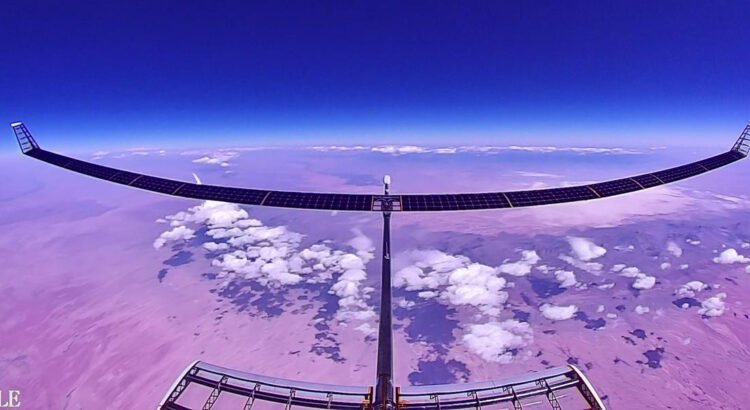By Hamed Khalkhali, Ph.D.,
The appetite for global connectivity is skyrocketing.
With internet traffic forecasted to exceed 396 exabytes per month in 2025, and satellite constellations reaching new heights in both number and noise, aerospace leaders are being forced to ask: Where do we go from here?
The answer may not be another trip into orbit, but rather a shift to the stratosphere.
High-altitude, long-endurance (HALE) unmanned aerial vehicles—solar-powered and capable of remaining aloft for weeks—are emerging as an alternative to traditional satellite infrastructure. These aircraft offer a persistent, flexible, and scalable way to expand access to real-time communications across remote, rural, or disaster-impacted areas.
In this article, I’d like to explore the growing need for HALE platforms, how they compare to traditional orbital solutions, and why stratospheric flight may hold the key to bridging future connectivity gaps.
Beyond the Bottleneck
Satellite networks have long carried the promise of universal coverage. However, they’re approaching a limit.
Interference, spectrum congestion, and delays caused by distance are introducing real barriers. Regulatory bodies are grappling with how to manage the swelling volume of orbital traffic. Meanwhile, the cost and time required to build and launch new satellites restrict quick adaptation.
In contrast, HALE UAVs operate at altitudes around 60,000 feet, above commercial air traffic, yet far below satellites. From this vantage point, they can deliver consistent line-of-sight connectivity with minimal delay. Their solar-powered systems enable extended missions without refueling, and they can be launched, repositioned, or recovered in a fraction of the time it takes to deploy space-based alternatives.
Adaptability in Motion
Unlike satellites locked into orbit, HALE UAVs offer operational agility. Missions can be re-tasked in real time to support changing priorities, from reestablishing communications in the aftermath of a natural disaster to monitoring wildfire conditions as they evolve.
In regions with little to no terrestrial infrastructure, these aircraft can serve as airborne relays, linking people and systems that would otherwise remain disconnected.
For instance, during the 2022 Tonga eruption, satellite communication disruptions and delays hampered rescue efforts. A fleet of solar-powered HALE UAVs could have provided low-latency coverage within hours, not days.
Similarly, in remote areas of sub-Saharan Africa where traditional telecom infrastructure is sparse, HALE platforms could support education initiatives, health services, and rural connectivity efforts with far lower cost and faster deployment than ground-based towers or satellites.
The advantages are practical. These aircraft provide continuous, high-resolution coverage that can be fine-tuned to mission needs. They can also be retrieved and upgraded instead of replaced—something that’s far more difficult and expensive with orbital hardware.
From a financial standpoint, HALE UAVs present a clear value proposition. Their development costs are significantly lower than those of new satellite constellations, and operational expenses are reduced thanks to solar energy and modular design.
Maintenance cycles are also more manageable, and because they fly within Earth’s atmosphere, they can be more easily serviced, upgraded, or redeployed.
Practical Applications Taking Flight
The use cases for solar drones are expanding across sectors. Let’s talk about a few.
Emergency Communications
During natural disasters, traditional networks can fail. HALE UAVs can quickly restore communication channels for first responders and public safety teams, even in areas that are otherwise inaccessible.
Agriculture
Farmers in remote or developing regions often rely on limited or outdated data. Persistent, aerial platforms can deliver high-frequency updates on soil moisture, crop health, and weather patterns—enabling smarter decisions and more resilient food systems.
Environmental Monitoring
Conservation groups can track deforestation, glacial melt, or illegal fishing operations over vast regions with real-time updates instead of relying on sporadic satellite passes. In fact, the U.S. Forest Service is already developing solicitations for HALE drone demonstration testing.
Defense and Security
Governments can deploy high-altitude, long-endurance UAVs for border surveillance, maritime domain awareness, and communication support in austere environments.
Live Event Coverage
Festivals, races, and sports tournaments in rural areas can benefit from temporary high-speed data networks set up by HALE drones, eliminating the need for cumbersome and expensive satellite uplinks.
This shift from space to stratosphere reflects a broader mindset change. Sometimes the most resilient systems aren’t those launched into orbit—they’re the ones that stay within reach.
Engineering the Edge at Swift Engineering
At Swift Engineering, we’ve taken on the challenge of designing and building solar-powered HALE UAVs capable of supporting this next chapter in global communications. Our focus is on flight endurance, modular design, and payload versatility. These platforms are being developed to carry out missions for weeks at a time, while maintaining continuous, low-latency coverage across thousands of miles.
We’re working on aircraft that use advanced composites for lightweight strength, thin-film solar arrays to power long-duration missions, and open payload bays that allow rapid reconfiguration for communication, imaging, or scientific instrumentation.
Because these systems operate closer to Earth, upgrades and maintenance are faster, more affordable, and more responsive to mission needs.
We’re not waiting years for the next satellite launch window. We’re building aircraft that can fly in a matter of days and serve for months.
Stratospheric Opportunity: A New Frontier Below Orbit
The skies are getting busier, and the demand for flexible, resilient infrastructure is growing just as quickly. As they turn their attention to high-altitude UAVs, aerospace engineers are opening a new chapter in how we connect, communicate, and respond.
In short: The next wave of global connectivity may not come from beyond the atmosphere, but from a quiet, solar-powered aircraft circling far above our heads—ready to respond, relay, and remain for as long as needed.
Hamed Khalkhali, Ph.D., is President of Swift Engineering.



